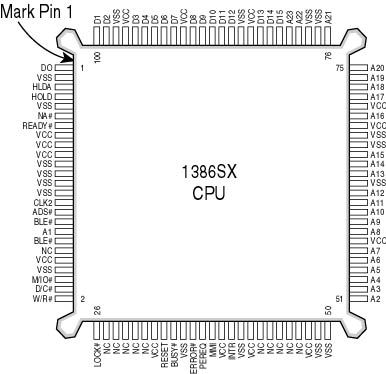Some forms of portable PC have existed from the days of the 8088. The early models, such as the Osborne and the original Compaq, were known as "luggables"-tipping the scales at close to 30 pounds. Their cases looked more suited for holding sewing machines than computers. Modern laptop computers started to gain popularity with the advent of the 386 chip and the use of flat screen monitors incorporated in the design, rather than conventional video tubes.
To seat 80286, 80386, and 486 CPUs (the latter are covered in the section that follows) on the more compact laptop motherboards, many vendors use plastic quad flat pack (PQFP) mounts, which are also more secure than traditional socket types designed for systems that will not be moved as much. PQFPs require a submount called a "carrier ring" (see Figure 4.11). PQFPs require a special tool for placing or removing a CPU. Be sure to get the tool before attempting repairs on PQFP-mounted CPUs.

Figure 4.11 PQFP (Plastic Quad Flat Pack)
80486
April 10, 1989, brought us the 80486 line of processors. Once again, the rallying cry was "better and faster." By this time, applications like CorelDRAW, Adobe PhotoShop, and desktop-publishing tools like PageMaker and Ventura Publisher were generating more interest in faster systems. Microsoft Windows was gaining popularity and on its way to becoming the standard desktop environment.
The 486 processor started life at 25 MHz and could address 4 GB of RAM and 64 TB of virtual memory. It is the first PC CPU to break the 1-million transistor mark with 1,200,000. It provided a built-in math coprocessor (older PC CPUs offered separate math coprocessors as an option-usually with a similar number ending in a 7 rather than a 6). The combination speeded up graphics programs that used floating-point math.
The 486SX and Beyond
Once again, Intel sought a way to increase sales without weakening the price of the flagship version of its 486DX CPU, so it added an SX version in April, 1991. This time, the company achieved its goal by removing the math coprocessor, reducing the number of transistors to 1,185,000. Users could upgrade the SX to a 486DX by adding an optional OverDrive processor to restore the missing component.
The 486 label was attached to other chip designs during its active development phase, both by Intel and third-party chip makers. The 486SL, a variant with a 20- to 33-MHz clock and 1.4 million transistors, debuted in 1992. It was very popular in high-performance laptop computers, running at lower voltage (3.3 volts instead of 5 volts) than the usual 486. The small (and for that time) powerful machines also included System Management Mode (SMM), which can dim the LCD screen and power down the hard disk drive-extending the life of the battery.